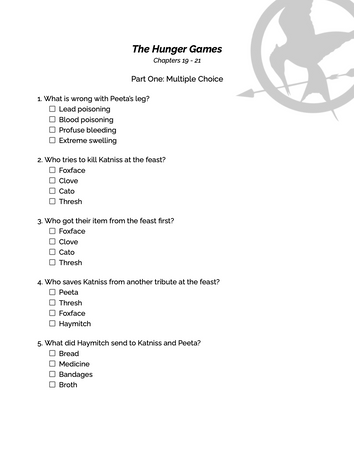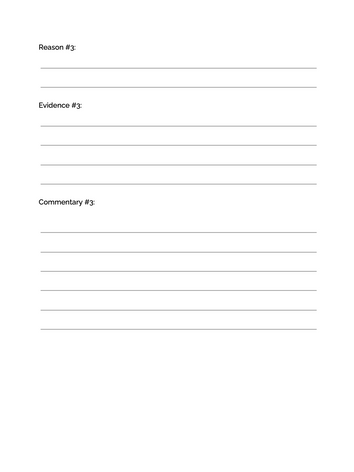
Patricia Forg
English Teacher
8th Grade English
May the Odds
I. Launch
I was surprised to discover that many students in this age group had no experience with The Hunger Games. The majority of each of my classes had never seen the movies or read the book, with some having never heard the title. This created a unique opportunity to engage the students in a way that would allow them to make predictions based on pieces of information I shared with them.
Students watched a 3-minute video that presented them with a series of images or quotes that hint to various scenes and themes that appear in the novel. The first time they viewed the video, students were not required to do anything. The second time, they used a worksheet to keep track of the images and write a description of each. The third and final time, they took notes on their responses to each image, particularly feelings or thoughts they brought up. At the end of this worksheet, students made predictions about what they thought the novel would be about based on these images, symbols, and quotes.
Students then viewed the movie trailer and reflected on their predictions, determining how accurate they were and what changes they'd like to make before starting the book.
My school site has many English Language Learners, and over my year here I've discovered that many students have difficulty completing assignments at home due to various roadblocks (lack of accessibility, homelessness, etc). To accommodate all students and ensure that they are reading, we read the book in class accompanied by an audiobook narrated by Tatiana Maslany. Each week we read around 3 chapters, depending on their length. At the end of each week, students took a comprehension quiz which was split into two main parts: multiple choice and short answer. Among the multiple choice questions are questions that ask them to determine the most likely meaning of various words based on the context they are used in.
In addition to comprehension quizzes, students were given vocabulary quizzes on most Fridays. Vocabulary was frontloaded at the beginning of each week using words they would come across in the novel.
II. Reading Comprehension
III. GENRE STUDY & ARGUMENTATIVE WRITING
As we read, students discussed themes they saw in the novel, identifying various dystopian aspects of Panem's society. I introduced a lesson on dystopias and utopias by showing them a video (left) about how to identify dystopias. This video introduced specific themes and ideas of a dystopian society, specifically drawing a connection between utopias and dystopias and how one (utopias) often leads to the other (dystopias). After viewing the video, students engaged in a class-wide discussion to check their understanding of dystopian societies. The class was posed with the question "Is The Hunger Games dystopian or utopian?". Students agreed on the whole that it was a dystopian world, however many began to ask questions about the world from the perspective of the Capitol and how they most likely viewed the world as utopian. It opened up an opportunity to discuss the way peoples' means affected the way they saw the world around them.
After viewing the videos, we read an article as a class that identified various and specific qualities of dystopian fiction. This was a lesson in annotation, specifically using google docs – students selected colors to represent different pieces of information we were looking for (i.e. yellow for dystopian qualities, pink for utopian qualities, green for things that they see in society today, blue for things they recognize in The Hunger Games, etc). We added notes as we highlighted and discussed the purpose of annotation and its usefulness in school. Students were then given another article that focused specifically on dystopian qualities in The Hunger Games that are dystopian, which they annotated independently.
Once students had a firm understanding of dystopias, we moved into our argumentative writing unit. Because this was their first argumentative writing piece, my goal was to allow them to learn how to formulate an argumentative paragraph by focusing on a question they knew how to answer: "Is The Hunger Games a dystopian novel?"
Students were given a note catcher which they filled out over the next few weeks as we discussed different elements that made up an argumentative essay, including claims, reasons, evidence, and counterclaims, etc. We also discussed ethos, pathos, and logos. As students learned the elements of an argumentative essay, they began formulating their own argumentative essay. Their writing was broken down into sections to ease their cognitive load.
Students started with a hook, bridge, and claim. They turned in a draft which I returned with specific feedback. Once this was finalized, they began to identify three reasons to support the claim that The Hunger Games is a dystopia. After completing this, students put the pieces together for a complete introduction paragraph.
When moving into the body paragraph, students began to look at their reasons individually. They used the articles about dystopias, the video, and the text of The Hunger Games itself to identify evidence that supported the reason they identified. Once they identified evidence, they began to build their commentary to explain how their evidence supports their reason and how the reason supports their claim. They put these elements together to create a clean and coherent body paragraph.
IV. ARGUMENTATIVE WRITING

V. LITERARY THEMES
To be completed when students complete the unit!



























